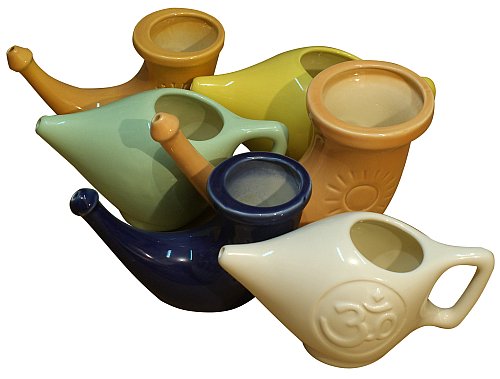Nasal rinsing
Nasal rinsing, or nasal irrigation is a personal hygiene practice in which the nasal cavity is washed.
Contents
Effects
- flushing out mucus and debris from the nose and sinuses
- removes nasal swelling
- relives facial pain, headache, halitosis, anterior rhinorrhea and nasal congestion caused by chronic sinusitis
- helping to breathe better during acute upper respiratory infection
- providing relief of the symptoms associated with allergic rhinitis
- preventing puffy eyes effect in case of allergies
NB! Do not do this if your nose is clogged completely. Please consult your physician in case you have any doubts about the safety of this method for you.
Origin, history
Nasal irrigation, which is called Jala Neti in Sanksrit, was developed as an ayurvedic Yoga tradition in ancient India, and is one of the six cleansing practices, or “kriyas”, of Yoga. It is believed that clear breathing leads to clear thinking; therefore, by purifying the nose, a higher state of meditation can be achieved. In addition, yogis believe that cleaning the nose helped overcome addictions, mood swings, and complaints.
File:Yogis neti pot.jpg
In the US, the Neti pot first gained popularity after Dr. Oz featured it on the Oprah Winfrey show in 2007.
In the countries of former Soviet Union, cleansing nose with saline water is considered as safe and effective folk method of treatment, that can be done even for infants.
Preparation
For this hygiene practice you will need: 1. Saline water solution 2. Container to administer the solution. 3. Sink or large bowl to lean at.
Saline water solution
You can either buy a saline solutions designed for nasal irrigation at the pharmacy, or make it on your own.
It's very simple:
- Measure one teaspoon of natural sea salt or non-iodized table salt (kosher, canning, or pickling salt) without any anti-caking agents or preservatives, as they can irritate the nasal and sinus cavities.
- Add 1/4-1/3 teaspoon of baking soda (optional).
- Add one glass (250 ml or 8 ounces) of lukewarm water that is either distilled, sterile, boiled and cooled, or properly filtered. Do not use tap water.
- Stir until the salt and baking soda are dissolved in the water. Make sure you are using a sterile instrument to stir the mixture.
Container to administer the solution
You have some choices here:
- Neti pot
- Bulb syringe
- Squeeze bottle
- Nasal irrigation device
- Just your cupped hands
Whatever you choose, make sure it is thoroughly cleaned and sterilized before and after usage, and your hands are washed.
Process
The procedure depends on the container you choose, but mainly it consists of such steps:
- Fill the container with saline solution.
- Bend over the the sink or a large bowl and turn your head to the side so that your ear is facing the sink. Keep your forehead at the same height as the chin, or slightly higher.
- Breathe through your mouth.
- Insert the spout of the container in the upper nostril. Hold it in such a way as to form a seal, preventing water from coming back out the entrance. Slowly raise the handle of your irrigation device. If you are using a syringe bulb, you may now begin to gently squeeze the saline solution out. If you are using a neti pot, simply let the water flow slowly into the upper nostril and out of the lower nostril. Empty ½ of the container per nostril. You may find it helpful to produce "Iii" sound while doing that.
- Repeat the process on the other side.
- Rest your head over the sink and blow your nose gently (without using your fingers to pinch it) to remove the excess water. Do this until most of the dripping has subsided and you can breathe through the nose easily again.
- Remove the rest of the water and completely clear out your nose by blowing into a tissue, without closing off either nostril.
- If the solution drains out of your mouth, lower your forehead in relation to your chin.
If you are using your hands only, do the following:
- Scoop up the saline solution with your cupped hands.
- Bend over the the sink or a large bowl and lean your head to your palms.
- Snort the water with your nose.
- Let the water pour out of your mouth. Make sure you let it out in time so you don't have choking feeling. It might take some practice to make it feel comfortable.
- Rest your head over the sink and blow your nose gently (without using your fingers to pinch it) to remove the excess water. Do this until most of the dripping has subsided and you can breathe through the nose easily again.
- Remove the rest of the water and completely clear out your nose by blowing into a tissue, without closing off either nostril.
